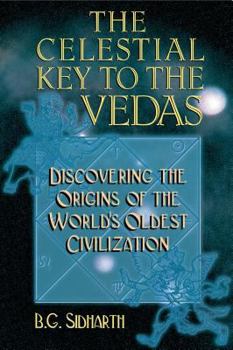The Celestial Key to the Vedas: Discovering the Origins of the World's Oldest Civilization
Select Format
Select Condition 
Book Overview
A leading astronomer proves that India had a thriving civilization capable of sophisticated astronomy long before Greece, Egypt, or any other world culture. - Provides conclusive evidence that the Rig Veda is 12,000 years old. - Establishes actual dates and places for many of the events in the Hindu epics. For more than a century scholars have debated the antiquity of the Vedas and their related literature, the Brahmanas and Puranas. Relying upon a host of assumptions from linguistic theory, anthropology, and archaeology, they have agreed upon 1500 b.c. as the earliest possible date for the Rig Veda, itself the oldest extant example of Indo-European literature. But in this groundbreaking book, astronomer B. G. Sidharth proves conclusively that the earliest portions of the Rig Veda can be dated as far back as 10,000 B.C. By deciphering the astronomical events and alignments contained in mythical and symbolic form in these ancient texts, Sidharth calls into question many if not all of the assumptions governing Indo-European prehistory. He explores such subjects as the astronomical significance of many Hindu deities and myths, the system of lunar asterisms used to mark time, the identity of the Asvins, and the sophisticated calendar of the ancients that harmonized solar and lunar cycles. Sidharth provides incontrovertible evidence that such "advanced" astronomical concepts as precession, heliocentrism, and the eclipse cycle are encoded in these ancient texts, passages of which make perfect sense only if these astronomical keys are known. Based on internal evidence in the Mahabharata and Ramayana, he also becomes the first to establish likely dates--and even places--for the events described in these famous epics. The Celestial Key to the Vedas is sure to astonish anyone concerned with astronomy, India, or the roots of civilization.
Format:Paperback
Language:English
ISBN:0892817534
ISBN13:9780892817535
Release Date:October 1999
Publisher:Inner Traditions International
Length:176 Pages
Weight:0.64 lbs.
Dimensions:0.5" x 5.9" x 9.0"
Related Subjects
Ancient Astronomy Astronomy & Space Science Hinduism History Occult Religion Religion & Spirituality VedasCustomer Reviews
1 rating
I'm no astronomer but I see validity
Published by Thriftbooks.com User , 23 years ago
I'm not an astronomer and can't validate Sidharth's assumptions but if taken that his assumptions are, in fact, true, then Sidharth continues to provide lucid examples of astronomical examples in the Rig Veda. Sidharth, also refers to archaelogical examples of the spread of Vedic culture to countries like Turkey, and Iran. Sidharth gives very clear cut examples of the dates that astronomical occurences in the Rig Veda mention. Though the date of 10,000 B.C. (or prior) for the Rig Veda may seem preposterous to many scholars, it is a date that is being seriously considered as an accurate date by many scholars, including Western scholars. In my opinion, this book is worth reading for anyone interested in ancient history, astronomy, and archaeology.






